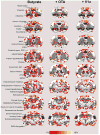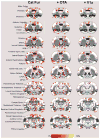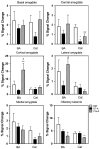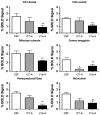Predator odor-evoked BOLD activation in the awake rat: modulation by oxytocin and V₁a vasopressin receptor antagonists
- PMID: 23219972
- PMCID: PMC3809104
- DOI: 10.1016/j.brainres.2012.11.045
Predator odor-evoked BOLD activation in the awake rat: modulation by oxytocin and V₁a vasopressin receptor antagonists
Abstract
Modulators of unconditioned fear are potential targets for developing treatments for anxiety disorders. We used blood oxygen level dependent (BOLD) MRI to investigate the pattern of brain activity during the presentation of a predator odor (cat fur) and a repulsive novel odor, butyric acid (BA), to awake rats. We further tested whether odor-evoked BOLD activation involved oxytocin (OT) and vasopressin V(1a) receptors. Animals were subdivided into groups either administered an intracerebroventricular injection of artificial cerebrospinal fluid (CSF), an OT receptor antagonist or a V(1a) antagonist (125 ng/10 μL each) 90 min before studies. BA odor evoked robust brain activation across olfactory, sensory, memory and limbic regions. The magnitude of BOLD activation across these regions was greater for BA than with cat fur. However, blockade of OT and V(1a) receptors differentially modulated odor evoked neural activity, particularly in the amygdala. OT and V(1a) antagonism preferentially modulated BOLD responding to BA in the cortical amygdala. While, OT and V(1a) antagonisms preferentially modulated BOLD responding to cat fur in the central amygdala. The data suggest that although OT receptors modulate BOLD activation in response to a novel and repulsive odor such as BA, vasopressin V(1a) receptors exert a modulatory influence on the neural response to a predator odor.
Copyright © 2012 Elsevier B.V. All rights reserved.
Figures






Similar articles
-
Oxytocin and vasopressin in the medial amygdala differentially modulate approach and avoidance behavior toward illness-related social odor.Neuroscience. 2010 Dec 29;171(4):1141-51. doi: 10.1016/j.neuroscience.2010.10.013. Epub 2010 Oct 8. Neuroscience. 2010. PMID: 20933576
-
Oxytocin modulates unconditioned fear response in lactating dams: an fMRI study.Brain Res. 2009 Dec 11;1302:183-93. doi: 10.1016/j.brainres.2009.09.043. Epub 2009 Sep 18. Brain Res. 2009. PMID: 19766607 Free PMC article.
-
Cat odor causes long-lasting contextual fear conditioning and increased pituitary-adrenal activation, without modifying anxiety.Horm Behav. 2009 Oct;56(4):465-71. doi: 10.1016/j.yhbeh.2009.08.002. Epub 2009 Aug 20. Horm Behav. 2009. PMID: 19699202
-
Peptide and non-peptide agonists and antagonists for the vasopressin and oxytocin V1a, V1b, V2 and OT receptors: research tools and potential therapeutic agents.Prog Brain Res. 2008;170:473-512. doi: 10.1016/S0079-6123(08)00437-8. Prog Brain Res. 2008. PMID: 18655903 Review.
-
Oxytocin and vasopressin modulation of the neural correlates of motivation and emotion: results from functional MRI studies in awake rats.Brain Res. 2014 Sep 11;1580:8-21. doi: 10.1016/j.brainres.2014.01.019. Epub 2014 Jan 30. Brain Res. 2014. PMID: 24486356 Free PMC article. Review.
Cited by
-
Gender-specific Single Transcript Level Atlas of Vasopressin and its Receptor (AVPR1a) in the Mouse Brain.bioRxiv [Preprint]. 2024 Dec 10:2024.12.09.627541. doi: 10.1101/2024.12.09.627541. bioRxiv. 2024. PMID: 39713333 Free PMC article. Preprint.
-
Where do we stand on fMRI in awake mice?Cereb Cortex. 2024 Jan 14;34(1):bhad478. doi: 10.1093/cercor/bhad478. Cereb Cortex. 2024. PMID: 38100331 Free PMC article.
-
The role of vasopressin in olfactory and visual processing.Cell Tissue Res. 2019 Jan;375(1):201-215. doi: 10.1007/s00441-018-2867-1. Epub 2018 Jun 27. Cell Tissue Res. 2019. PMID: 29951699 Free PMC article. Review.
-
Photoacoustic imaging of vascular hemodynamics: validation with blood oxygenation level-dependent MR imaging.Radiology. 2015 Apr;275(1):110-8. doi: 10.1148/radiol.14140654. Epub 2014 Nov 20. Radiology. 2015. PMID: 25423146 Free PMC article.
-
Oxytocin receptor signaling contributes to olfactory avoidance behavior induced by an unpleasant odorant.Biol Open. 2018 Sep 26;7(9):bio029140. doi: 10.1242/bio.029140. Biol Open. 2018. PMID: 29945877 Free PMC article.
References
-
- Appenrodt E, Schnabel R, Schwarzberg H. Vasopressin administration modulates anxiety-related behavior in rats. Physiol Behav. 1998;64:543–547. - PubMed
-
- Bielsky IF, Hu SB, Szegda KL, Westphal H, Young LJ. Profound impairment in social recognition and reduction in anxiety-like behavior in vasopressin V1a receptor knockout mice. Neuropsychopharmacology. 2004;29:483–493. - PubMed
-
- Blanchard DC, Markham C, Yang M, Hubbard D, Madarang E, Blanchard RJ. Failure to produce conditioning with low-dose trimethylthiazoline or cat feces as unconditioned stimuli. Behav Neurosci. 2003;117:360–368. - PubMed
Publication types
MeSH terms
Substances
Grants and funding
LinkOut - more resources
Full Text Sources
Other Literature Sources
Miscellaneous

